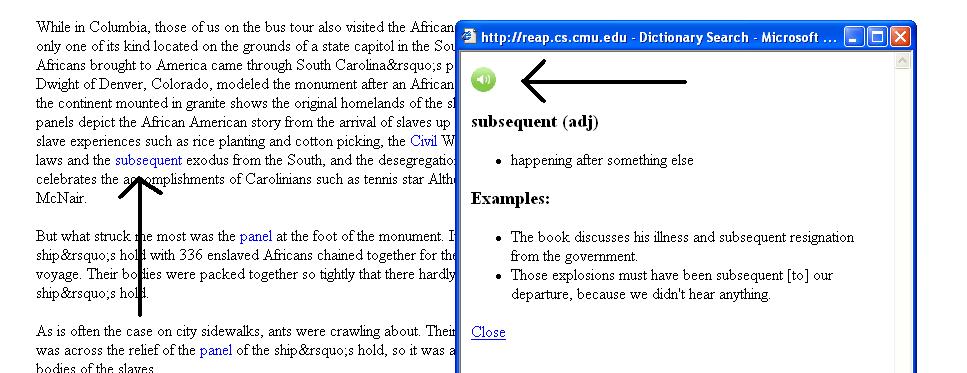Difference between revisions of "REAP Multimodal Learning Fall 09"
(→Hypotheses) |
|||
| Line 41: | Line 41: | ||
[[Image:MultimodalLearning.JPG]] | [[Image:MultimodalLearning.JPG]] | ||
| − | |||
| − | |||
| − | |||
| − | |||
| − | |||
| − | |||
| − | |||
| − | |||
| − | |||
=== Glossary === | === Glossary === | ||
| Line 61: | Line 52: | ||
[[Normal post-test]] scores | [[Normal post-test]] scores | ||
| − | [[Normal post-test]] scores for | + | [[Normal post-test]] scores for words that have been instructed in both modes |
| − | [[Long-term retention]] test scores, same post-test but administered | + | [[Long-term retention]] test scores, same post-test but administered in Spring 10 |
| − | Evidence of [[Transfer]]: sentence production tasks for target words, | + | Evidence of [[Transfer]]: sentence production tasks for target words, assessed through open-ended questions in post-test |
=== Independent variables === | === Independent variables === | ||
| − | + | Number of instructions in visual modes per word | |
| + | |||
| + | Number of instructions in auditory modes per word | ||
=== Hypotheses === | === Hypotheses === | ||
Latest revision as of 18:19, 9 November 2009
Contents
REAP Study on Multimodal Learning of Vocabulary
Logistical Information
| Contributors | Gabriel Parent, Luis Marujo, Adam Skory, Maxine Eskenazi |
| Study Start Date | October 13, 2009 |
| Study End Date | November 20, 2009 |
| Learnlab Courses | English Language Institute Reading 4 and 5 (ESL LearnLab) |
| Number of Students | 68 |
| Total Participant Readings (est.) | 816 |
| Data in Datashop | no |
Abstract
The term “Multimodal learning” refers to learning where two or more different modes are used in order to integrate a Knowledge Component. In the particular case of vocabulary, the typical modes would be:
- Visual ( visual word form )
- Auditory ( auditory word form )
- Pictorial ( picture of the concept subjacent to a word )
The object of this study is to evaluate the relationship between the visual and auditory modes in learning vocabulary.
Word learning episodes can occur through writing and speech. Spoken language knowledge is important as a foundation for reading, and may support word learning through reading. The objective of this study is to investigate under what conditions does spoken language input, when combined with written input, lead to better word learning for L2 learners.
The REAP software has been used for the first five years in the English Language Institute of the University of Pittsburgh to teach vocabulary through reading words in context (Heilman et al., 2006). It allows the study of many questions in vocabulary learning, text learning, and motivation for reading. Past work suggests that ESL students may know the oral form of a word without knowing the written form and raise the possibility that this knowledge could help support learning word meaning from reading documents.
This is an exploratory study that will use REAP to present oral and written input to students in the ELI LearnLab. For example, while allowing students to hear as well as see words should help learning, in some instances this form of oral assistance may create too much cognitive load, thus distracting the student from attending to word meaning. The goal is explore questions such as this while establishing materials and spoken language procedures that can work in the in-vivo ELI setting.
Here is an example of a typical instruction where the student can hear the word as he gets the definition to a word:
Glossary
Research question
Under what conditions does spoken language input, when combined with written input, lead to better word learning for L2 learners?
Dependent variables
Normal post-test scores
Normal post-test scores for words that have been instructed in both modes
Long-term retention test scores, same post-test but administered in Spring 10
Evidence of Transfer: sentence production tasks for target words, assessed through open-ended questions in post-test
Independent variables
Number of instructions in visual modes per word
Number of instructions in auditory modes per word
Hypotheses
Students that got instructions in both modes will have experienced more robust learning than students that only got visual instructions.
Further Information
Annotated bibliography
Heilman, M., Collins-Thompson, K., Callan, J. & Eskenazi, M. (2006). Classroom success of an Intelligent Tutoring System for lexical practice and reading comprehension. Proceedings of the Ninth International Conference on Spoken Language Processing.
